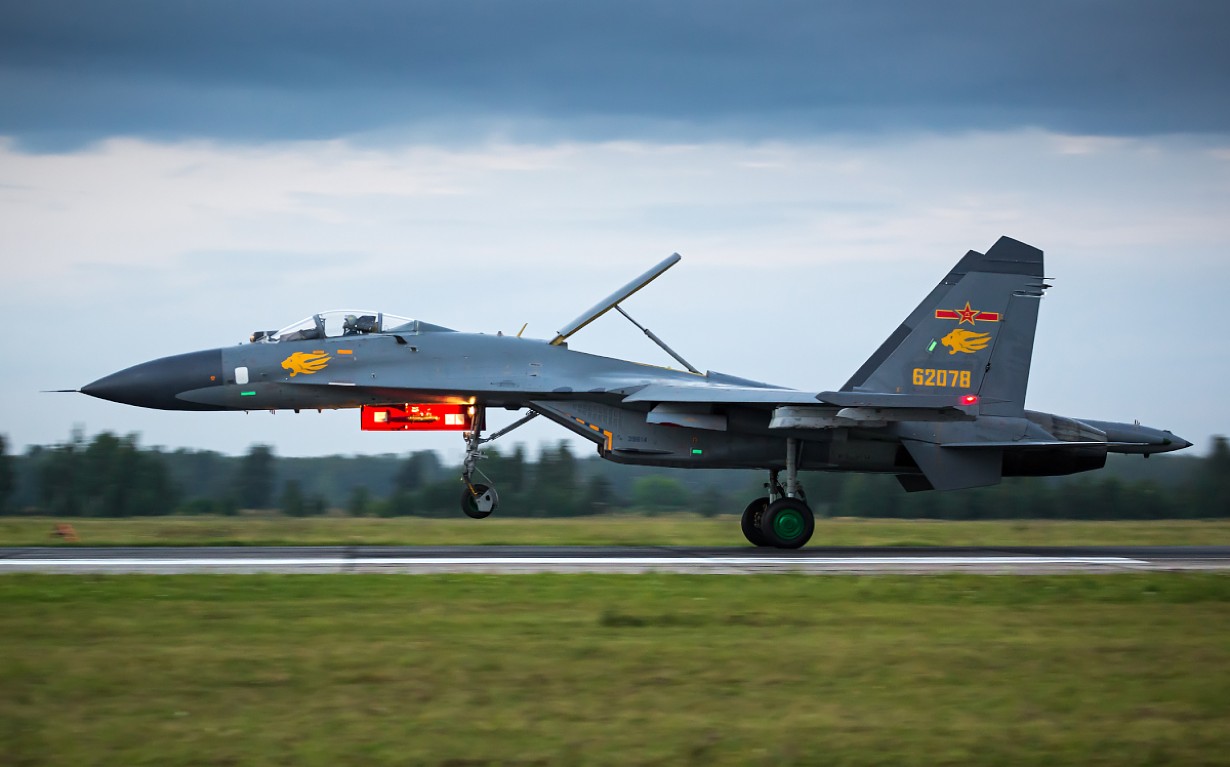Recently, a US surveillance aircraft had a very close and dangerous encounter with a Chinese Shenyang J-11 fighter jet over the South China Sea. This was the second encounter of an American surveillance aircraft with a J-11, which appears to be a ‘serial harasser’ in the region.
On February 24, a Chinese J-11 fighter jet armed with four air-to-air missiles intercepted an American P-8 Poseidon maritime patrol aircraft while the US media journalists were aboard the plane.
As per reports, the American aircraft was shadowed by the J-11 for well over an hour, and at one point, the Chinese fighter jet was barely 500 feet off the port side of the US surveillance aircraft.
The US journalists could even see the pilots of the J-11 and the weapons the Chinese warplane was armed with.
The incident came shortly after a US Air Force (USAF) RC-135 aircraft had a dangerously close encounter with a Chinese J-11 fighter jet in December 2022 over the South China Sea.
The Chinese fighter jet came within 10 feet (three meters) of the American surveillance aircraft, forcing the latter to perform evasive maneuvers to avoid a collision.
“The long-term trend is more and more aggression” by Chinese fighter pilots, said Capt. Will Toraason, the commander of U.S. Navy surveillance aircraft.
There is a video of the incident, presumably shot from the RC-135. It shows the Chinese fighter closely approaching the American surveillance aircraft on its left before briefly flying in front of it and drifting away.
At the time, the J-11 was said to be armed with four air-to-air missiles, including two PL-12 Beyond Visual Range (BVR) air-to-air missiles (AAM) and two PL-8 short-range AAMs.
In some ways, the J-11 aircraft is coming across as a serial harasser in the region.
For instance, the Chinese J-16 fighter jet, which is also inspired by the J-11, is said to have pestered an Australian P-8 aircraft, going as far as releasing a bundle of chaff, which contains small pieces of aluminum, some of which were ingested into the engine of the Australian aircraft.
CNN bro in a US spy plane over South China Sea:
"Why Chinese war plane fly so close to us!" pic.twitter.com/0xZxPKpMl8— Carl Zha (@CarlZha) February 27, 2023
Shenyang J-11 Fighter Jet
The Shenyang J-11 fighter jet is a twin-engine, single-seat warplane based on a licensed-built version of the Russian Sukhoi Su-27SK Flanker fighter, which is why it is also nicknamed the Flanker or Flanker B+.
China’s People’s Liberation Army Air Force (PLAAF) had been looking to produce a counterpart to the fourth-generation fighter jets used by NATO countries like the F-16 Fighting Falcon.
China’s first attempt was in the 1970s, which entailed the Shenyang factory combining a light fighter design of the Soviet MiG-19 with a British Rolls-Royce Spey 512 engine. This project was known as the J-11, but it ultimately failed.
However, this idea was revived two decades later when China signed an agreement in 1990 with the Soviet Union to acquire Su-27s. It marked one of the very last major military deals for the USSR with a foreign power’s military before its demise in December 1991.
For the first time, this agreement gained China access to fighter jets comparable to the NATO F-15 Eagles, F-14 Tomcats, Tornados, or Eurofighters.
In 1996, China signed another contract with Russia which entailed the co-production of 200 Su-27s. The Shenyang Aircraft Corporation was selected to assemble pre-fabricated bits and pieces of Su-27 airframes partially assembled in Russia. These domestically built Su-27s were designated as J-11s.
The co-production of J-11s began in 1998. However, it was halted after around 100 aircraft were built, reportedly because China began developing the J-11B variant of the plane with domestic subsystems, which was said to violate the co-production agreement.

While the original J-11 is an air superiority aircraft like the Soviet-origin Su-27SK, the J-11B ‘Flaming Dragon’ is a multirole variant. Also, 90 percent of this aircraft variant is said to be based on China’s homegrown subsystems and components.
China also replaced the Russian-made Lyulka Saturn AL-31 engines in some of the J-11Bs with WS-10 engines. There is also an improved version called the J-11D, equipped with Active Electronically Scanned Array (AESA) radar and an upgraded WS-10 engine.
Notably, China’s J-15 carrier-capable fighter and the J-16 multirole aircraft are also said to be inspired by the J-11 design.
In particular, the J-16 is based on the J-11BS, a two-seat combat-capable trainer version of the J-11, and the Russian-made twin-seat Su-30MKK Flanker. It has improved avionics and uses Chinese WS-10B engines.
- Contact the author at tanmaykadam700@gmail.com
- Follow EurAsian Times on Google News




